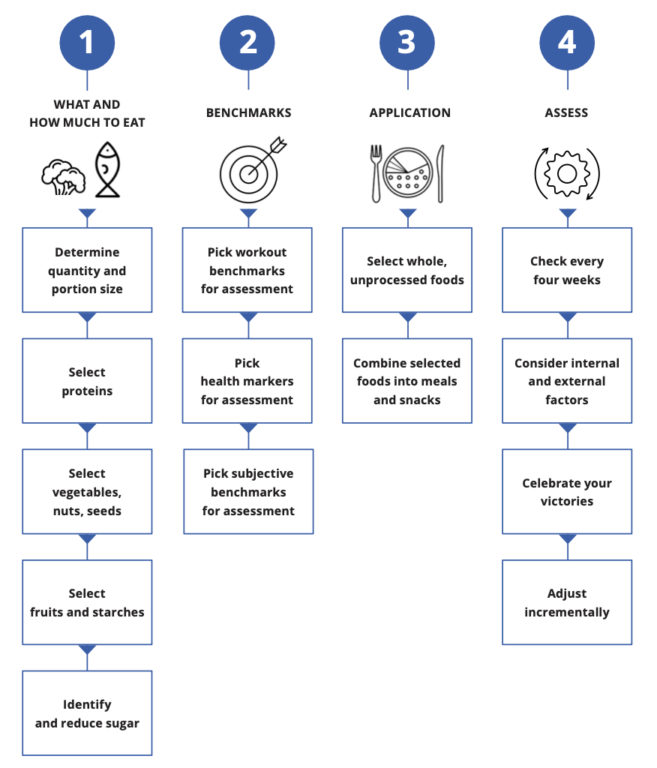How many times has this happened to you? An athlete — who you know comes to the gym consistently and gives it everything they have in class — comes up to you after class and expresses their frustration they aren’t making progress. They’re stuck at certain weights, they aren’t getting faster, and everyone around them seems to be getting stronger, fitter, and faster.
You ask them about their diet, and they tell you they eat cleanly and follow CrossFit’s nutrition recommendations.
“Eat meat and vegetables, nuts and seeds,
some fruit, little starch, and no sugar.
Keep intake to levels that will
support exercise but not body fat.”
They “look” healthy and are not visibly overweight, but you know something’s up. You ask them what they eat, how much, and if they weigh and measure their intake.
What they eat is spot on. However, it falls apart when they say how much they eat and they don’t weigh and measure their food.
You know the next step in the conversation will be tricky, but CrossFit doesn’t apologize about nutrition, and neither should you. You say, “Your nutritional choices are getting in the way of your results.”
This may be really tough for some members to hear, especially when they think they are doing everything right; they’re paying attention to their diet, making hard choices in the kitchen, and aren’t “cheating.”
However, getting quality right is only one part of the equation. Quantity and macronutrient ratios matter a lot and are often the part of our nutrition recommendation that gets missed: “Keep intake to levels that will support exercise but not body fat.” This is a hard and fast rule. No excuses. No apologies. This conviction is not meant to discourage them but to help them buy in and commit to the process.
So, if a member or athlete wants to optimize their results, they need to quantify what they’re eating with greater precision and accuracy. They need to do this:

Now that you know what they need to do, and they’re giving you a few nods to indicate their agreement, it might be tempting to get them to change starting now. Resist the temptation to try and fix it all right away. They may know what they need to do, but it’s easier said than done. Instead, share a few resources such as the image above, our nutrition course, this video on weighing and measuring, and this video on implementing quality and quantity. You can also recommend nutrition apps like MyFitnessPal for tracking and understanding their food intake. Or invite them to set up a time to chat with you outside of class or with a nutrition coach you trust.
When giving recommendations on weighing and measuring for the first time, we recommend keeping it simple with a balanced macronutrient approach that is 40% carbohydrate, 30% protein, and 30% fat. This approach will educate athletes on what foods fit in with certain macronutrients and allow for adjustments to easily be made in the future. The quantity a person should consume is based on an individual’s body weight and activity level, which we go into detail about in our online nutrition course. Or, if you want to avoid the math, you can also give a baseline starting point of 2,500 calories for men and 2,000 calories for women and implement 40-30-30 from there. What matters most is not the specific number — it’s that the athlete just gets started weighing and measuring!
After establishing their baseline, be sure to check in with them over the next few weeks and help them make subtle adjustments as needed. The fact that they came to you means they trust you. Hopefully, it also means they want to do what it takes to improve their results. So, be the kind of CrossFit trainer everyone needs — one who doesn’t apologize and doesn’t let people off the hook but understands that every athlete walks into the gym with a history. Overcoming that history may take a minute, weeks, months, or even years. That’s OK. Everyone will be there for them when they’re ready.
If you’d like to take a deep dive into food quantity, check out our nutrition course here.
Comments on CrossFit Doesn't Apologize (about Nutrition), and Neither Should You
Isnt it better just to recommend to go to a nutricionist? General advices, as the ones described, can give a general view on how to improve athletes their eating habits but specific needs must be assessed by a professional am i correct?
The information above meets needs regarding food and nutrition that (I believe) aren't specific at all. Most people will have life changing results following only this general scaffold. A nutritionist usually gives you a fixed set of daily meals, while education can help people become nutritionally autonomous.
CrossFit Doesn't Apologize (about Nutrition), and Neither Should You
2